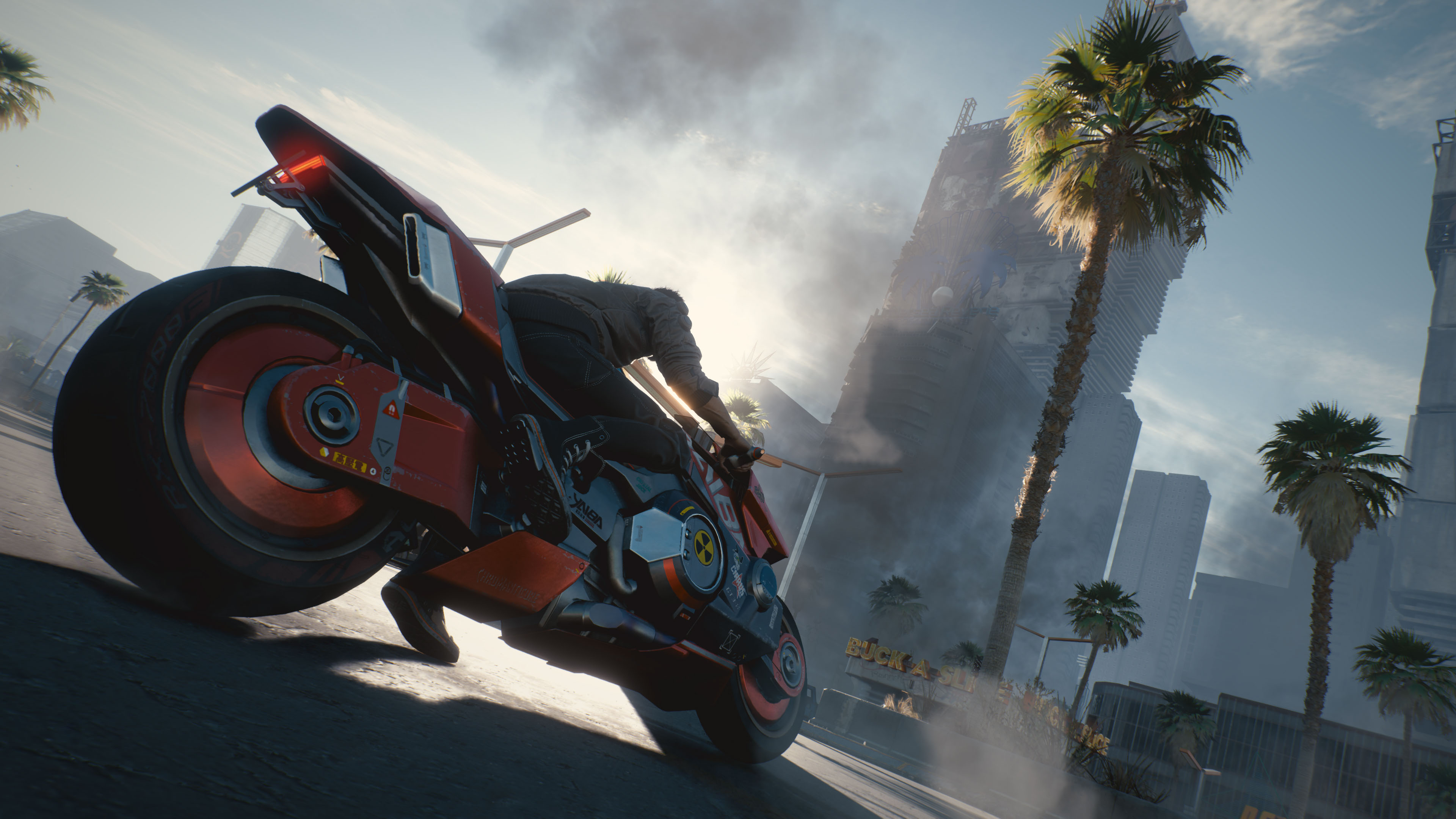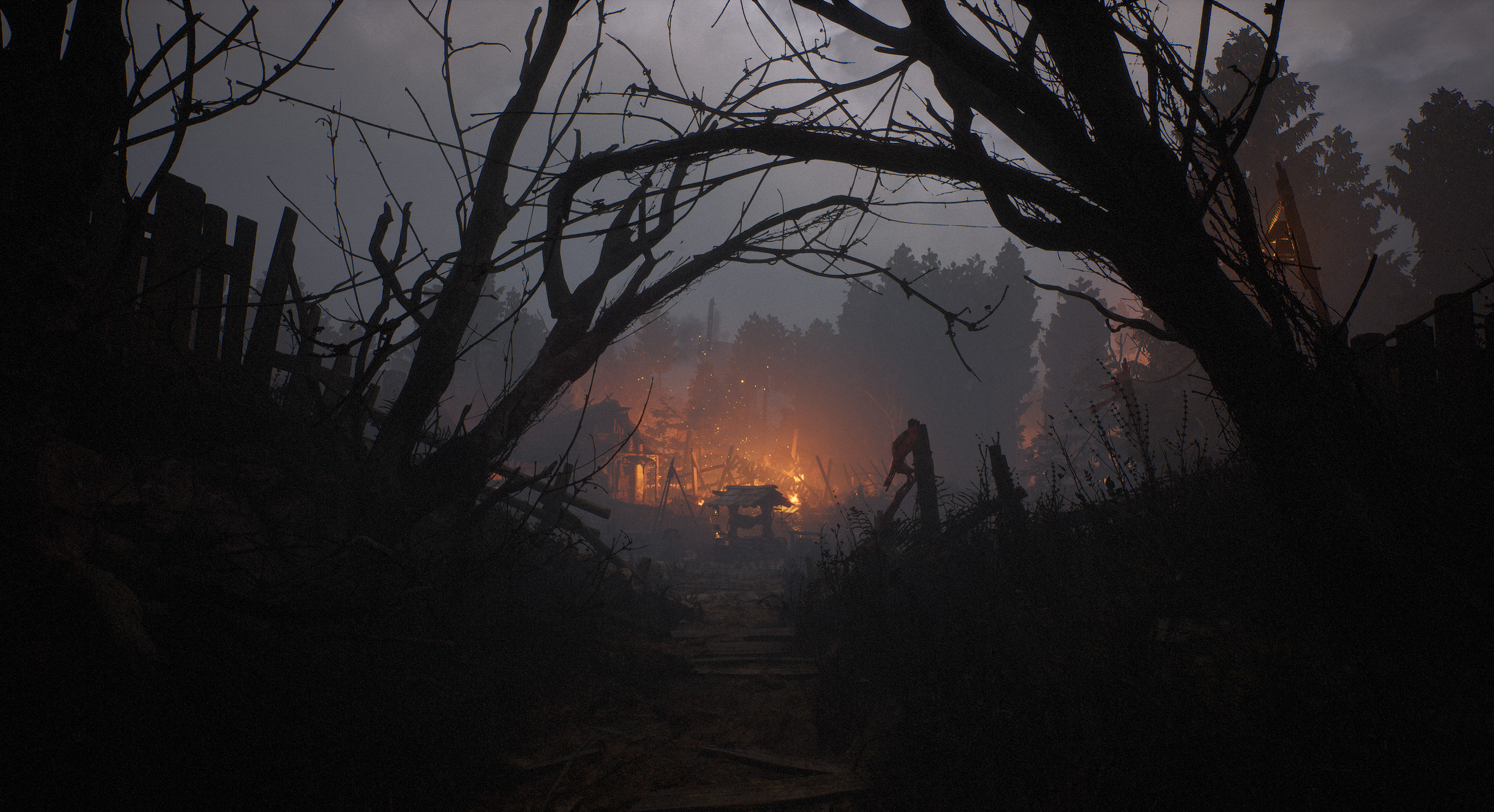Building the dark future of Cyberpunk 2077 with Megascans
Cyberpunk 2077 — the most anticipated game of the year — is finally here. CD PROJEKT RED gives us a sprawling, intricate world with Night City and the Badlands in this deep role-playing experience based on the work of Mike Pondsmith. Cyberpunk 2077 offers unprecedented verticality, exploration, and a deep array of player choices. The game promises many unforgettable characters — and to us — the design and art direction of Night City’s environments stand apart as a character all their own.
We caught up with Kacper Niepokólczycki and Michał Janiszewski, environment art leads at CD PROJEKT RED, who worked with their teams to bring to life the rich lore of the franchise in tandem with creating an engaging experience for players. We asked them how they took on the challenge of articulating Mike Pondsmith’s uncompromising vision of the dark future while ensuring that players were as immersed as possible in the world and its many stories.

Kacper Niepokólczycki — Lead Environment Artist, CD PROJEKT RED
At CD PROJEKT RED since 2014, Kacper has worked both on The Witcher 3: Wild Hunt, as well as on the game’s second expansion, Blood and Wine. Following this, he began to work on Cyberpunk 2077, beginning with the earliest designs and block-outs for Night City and the Badlands. He also leads a team of environment artists. Before joining CD PROJEKT RED, he collaborated with The Farm 51 on projects such as Painkiller HD, Deadfall Adventures, and Get Even.

Michał Janiszewski — Lead Environment Artist, CD PROJEKT RED
Working at CD PROJEKT RED since 2013, Michał helped build the world of The Witcher 3: Wild Hunt and its two expansions before working on Cyberpunk 2077. He currently leads the Warsaw-based Environment Art team to bring the dystopian world of the dark future to life, ensuring that the artistic vision of the game is upheld both in the open world and in the quest locations. Michał pushes for environment-based storytelling, ensuring the compositions lead to interesting and beautiful paths for players to follow.
Q: Keeping true to the essence of its source material, we imagine the world of CYBERPUNK 2077, and Night City, in particular, had to resemble the real world yet look nothing like it in every respect. How did the team approach this creative challenge?
Kacper: Our work always starts with story and lore. In this case, we began with the source material, which for us was Cyberpunk 2020. We scoured every map and read all the books and manuals as we tried to get into the mindset Mike Pondsmith had while creating Cyberpunk 2020. We were also fortunate enough to work with Mike directly, which was a great help to make sure we were on the right track. Having that solid base in place, we could then begin to build our version of Night City of the year 2077.

In Cyberpunk 2077, Night City is divided into six districts. Our main goal was to make them all very distinct from each other, yet connecting together into one big, cohesive cityscape. We knew we wanted to touch specific themes in certain locations, so we started grabbing references to inform the atmosphere of the districts. We used a lot of real-life city examples, such as Los Angeles, Detroit, and Chicago, but we also made full use of our imagination, fuelled of course by books, comics, and other cyberpunk media — including movies and games. We had close support from the concept art team to test our wild ideas, and we also had help from urban planners to make sure the city was constructed in a very logical way. Night City had to feel like it could be a real-life city; roads had to flow properly, for instance, and this approach informed our work greatly, helping us decide exactly where specific themes would fit most naturally. This makes sure that we maintain a realistic, grounded feeling, but with our custom Cyberpunk twist.
On top of that, our art direction for the game has four main pillars — we call them the four styles. Poor districts have the look of Entropism, where the materials used are mostly cheap, and poor quality — like old concrete or old weathered plastic. Some other districts have a very Kitsch look, with glowing neons and unorthodox-looking facades. A lot of colorful, rounded plastics can be seen in Kitsch districts. Conversely, corporate districts have a very slick look to them, defined by the imposing yet sleek Neomilitarism style. In these areas, you’ll find clean, shiny metal surfaces and smooth glass, with darker tones and a minimalist feel. The richest parts of the city, like North Oak, are pure Neokitsch. This style uses mostly clean, elegant, shiny wood, and gold. It’s the style of the ultra-rich, going back to the roots of Kitsch but bringing a vast luxuriousness not many in Night City are able to achieve. Every style has certain roles that we wanted to maintain throughout our design process.
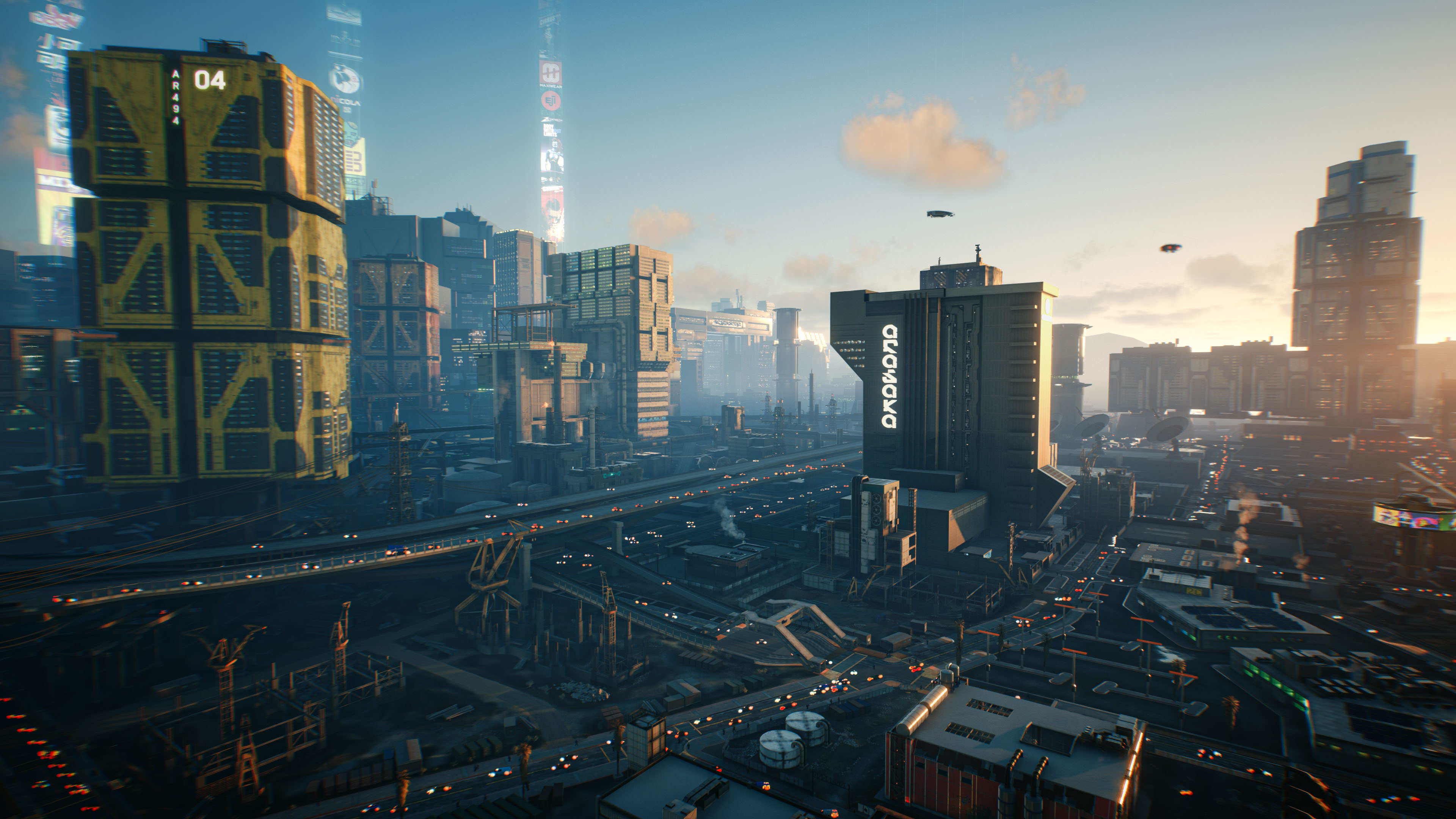

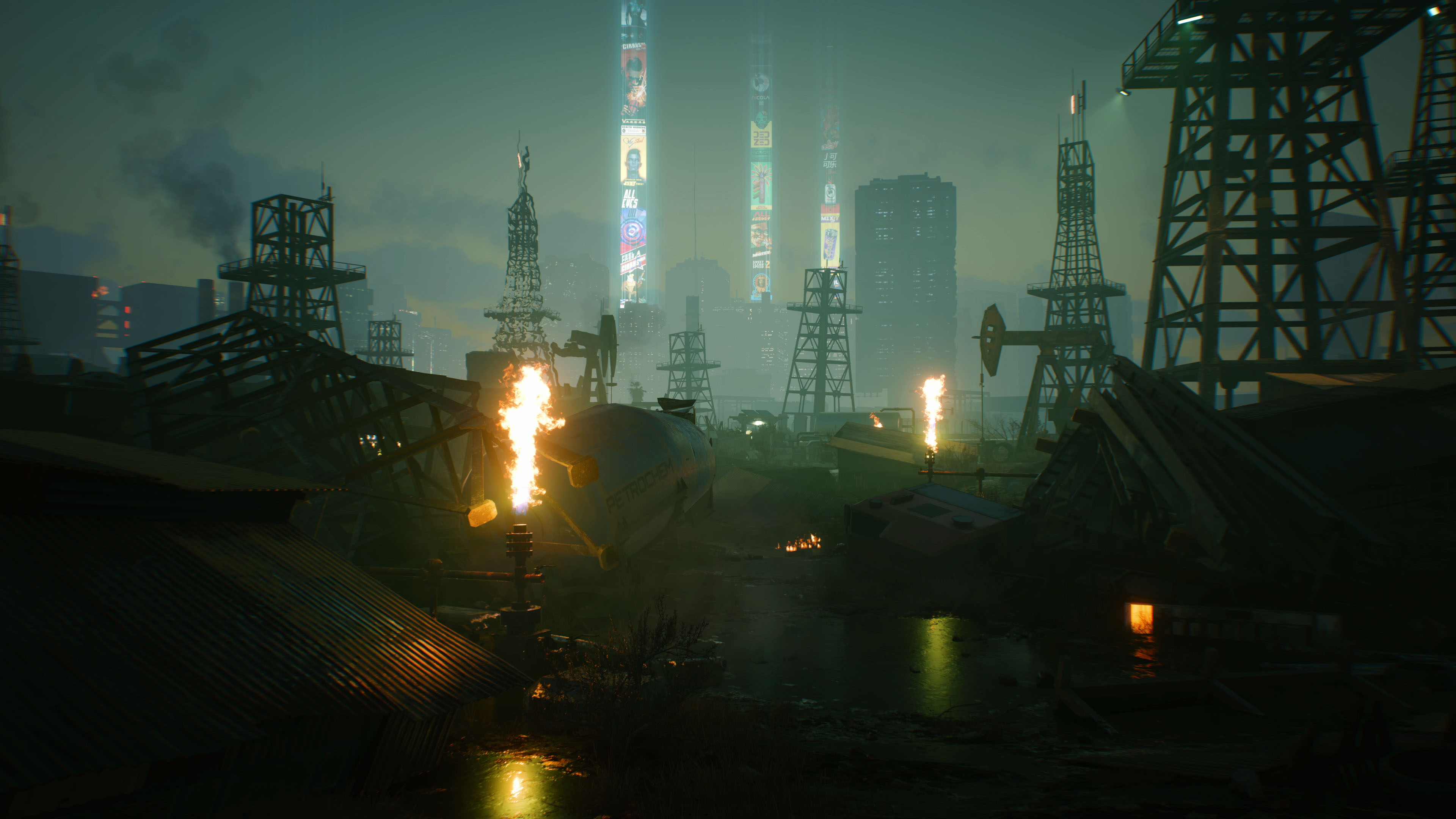

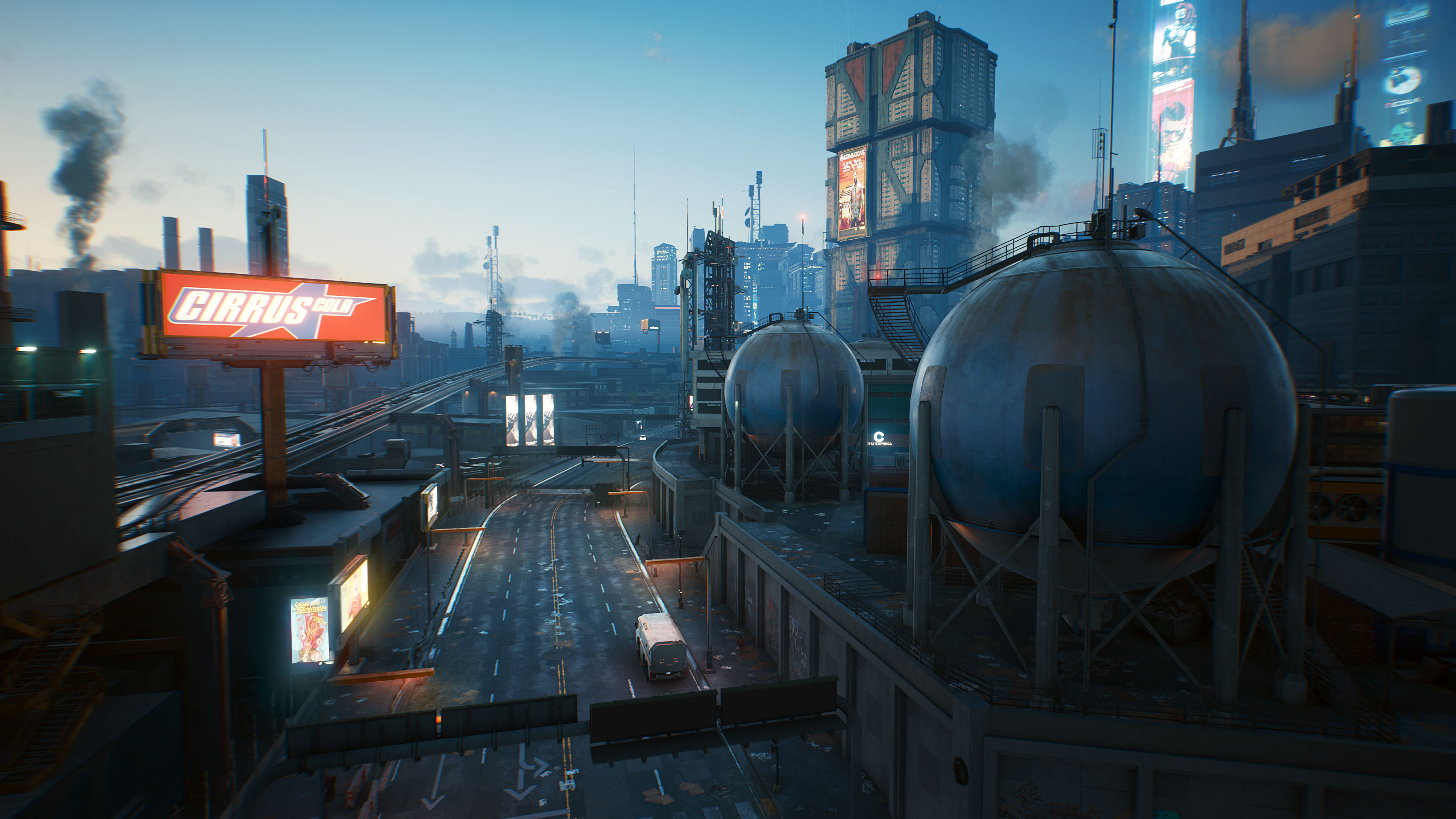
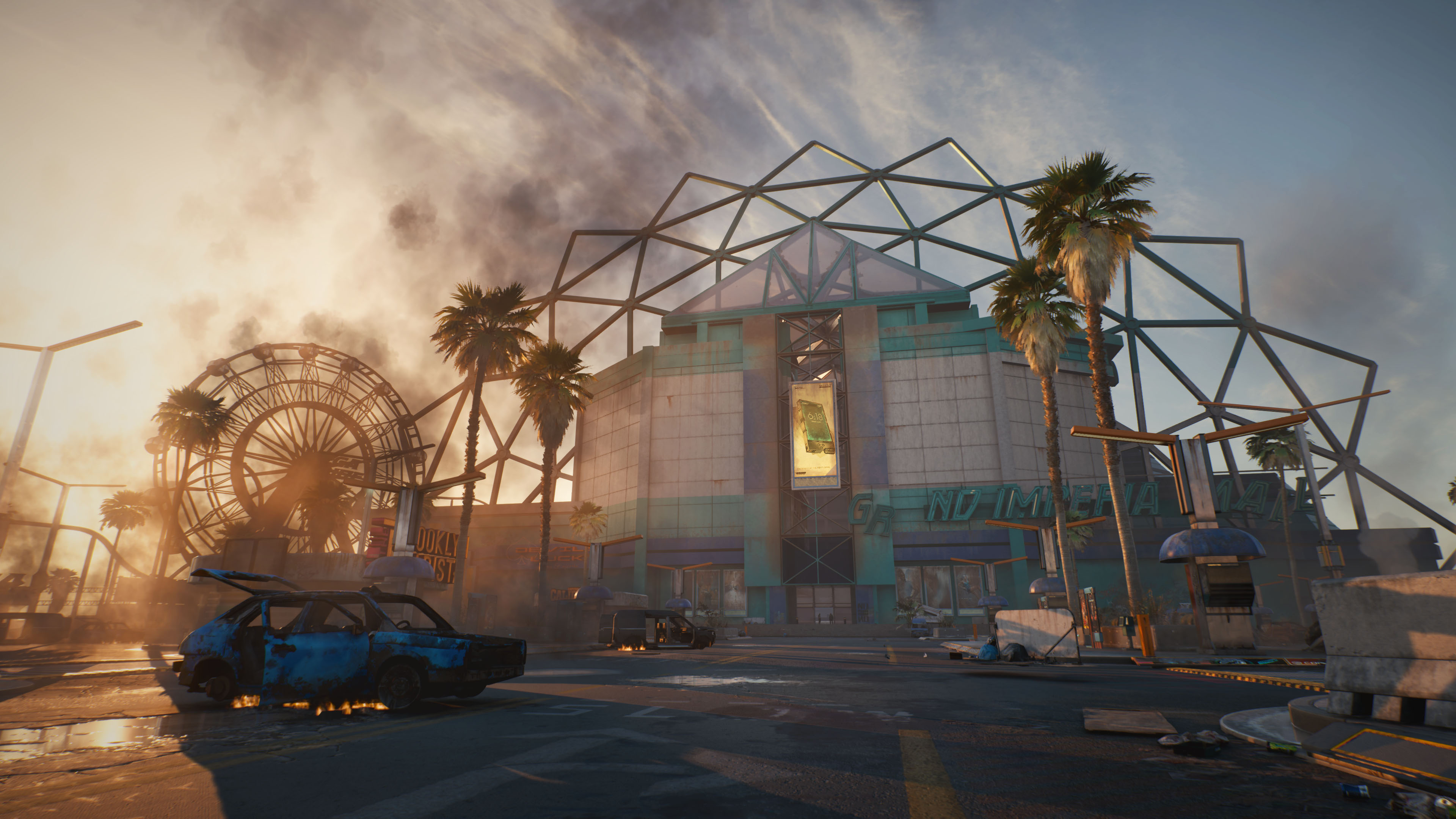
We also often used the “rule” of contrasts. Think about a typical street in L.A., with its iconic palm trees. The question in our heads was, ‘what could we build on that street to make it still look like an L.A. street, yet different?’ The answer might be through adding massive, looming structures in the background, with some twisted architecture, or sometimes, even putting a big cargo AV over street level would be enough. Or, we might use smaller details like commercials and the products they advertise. Actually, we pushed commercials in our world very far. We wanted to show how far and in your face corporations will go to force consumerism upon people and often explicit commercials are a fast, effective way for them to achieve that. Cyberpunk’s world is also one where the flora, while present and sometimes abundantly so, is having a hard time thriving. Look closely you may notice that some of the palms, known for being able to withstand the harshest conditions, have special, custom devices watering them. Basically, in every frame, we tried to put something out of the ordinary, but not at all unrealistic, in order to add to the futuristic, dystopian look.
Having all those pieces, our talented environment level art team went in and started to block-out the city, and with every pass, we added more and more details. A lot of great ideas also were created by artists on the fly. That’s why this city is so unique and has this very organic, hand-made quality to it.
Q: From a world-building perspective, CYBERPUNK 2077 straddles the lines between open-world RPG and tight FPS. How was the team able to create this balance of exploration and storytelling through the game’s level design and environment art?
Kacper: Our goal was to create a first-person-perspective RPG. In our opinion, FPP gives the player a much more immersive experience, both in and outside of combat, and while there is a fair amount of combat in the game, not just of the shooting variety, there’s just as much exploration and adventure to be had set within the role-playing framework of the game.
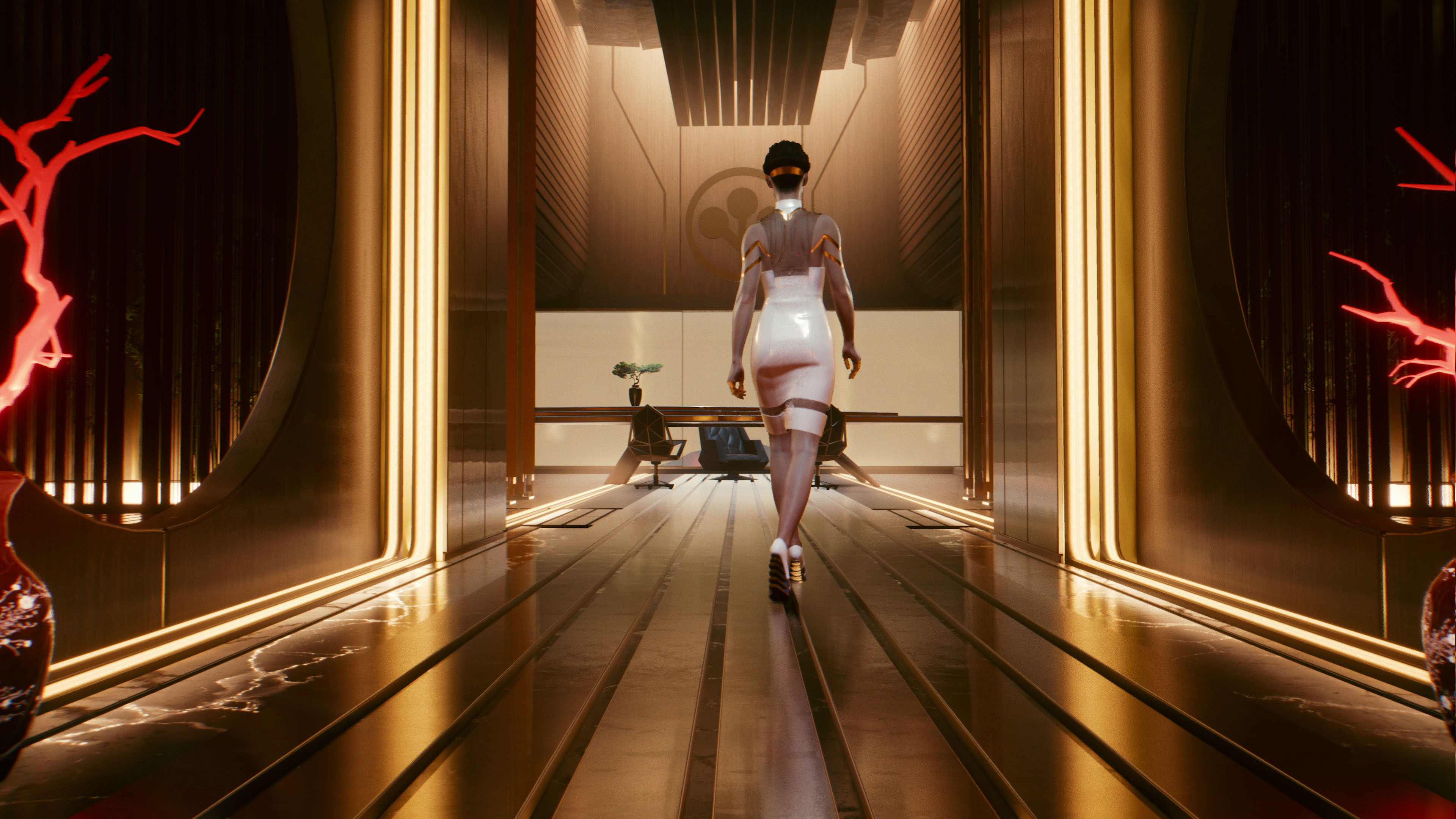
Our Environment Art team worked very closely with the Level Design team — responsible for designing combat spaces, quest locations, and basically wherever there are combat scenarios in Night City. Our level designers set up the layout of these areas, adding cover to the environment, for example, and generally making sure gameplay provided the maximum opportunity for fun. Those less combat-heavy places were designed from scratch by the Environment team. Having all the block-outs from both open-world and combat-focused / quest locations, we carried out an art pass and made sure the connection between every area was seamless. For example, cover that was integrated by our level designers was left exactly as it had been set up, but after our pass, elements of cover benefited from taking on a look that had them fit more naturally with the surroundings. This approach ensures that our environmental storytelling supports the locations players are exploring, or the quest they’re taking on. Environmental storytelling for us is extremely important; even streets in the middle of nowhere which might at first glance look like there’s nothing there may feature a small, self-contained story. Maybe a group of homeless people live there struggling to survive, or maybe there’s a destroyed car just sitting there on the side of that road with a body next to it — was there an accident here, or was someone attacked? The possibilities were limitless.
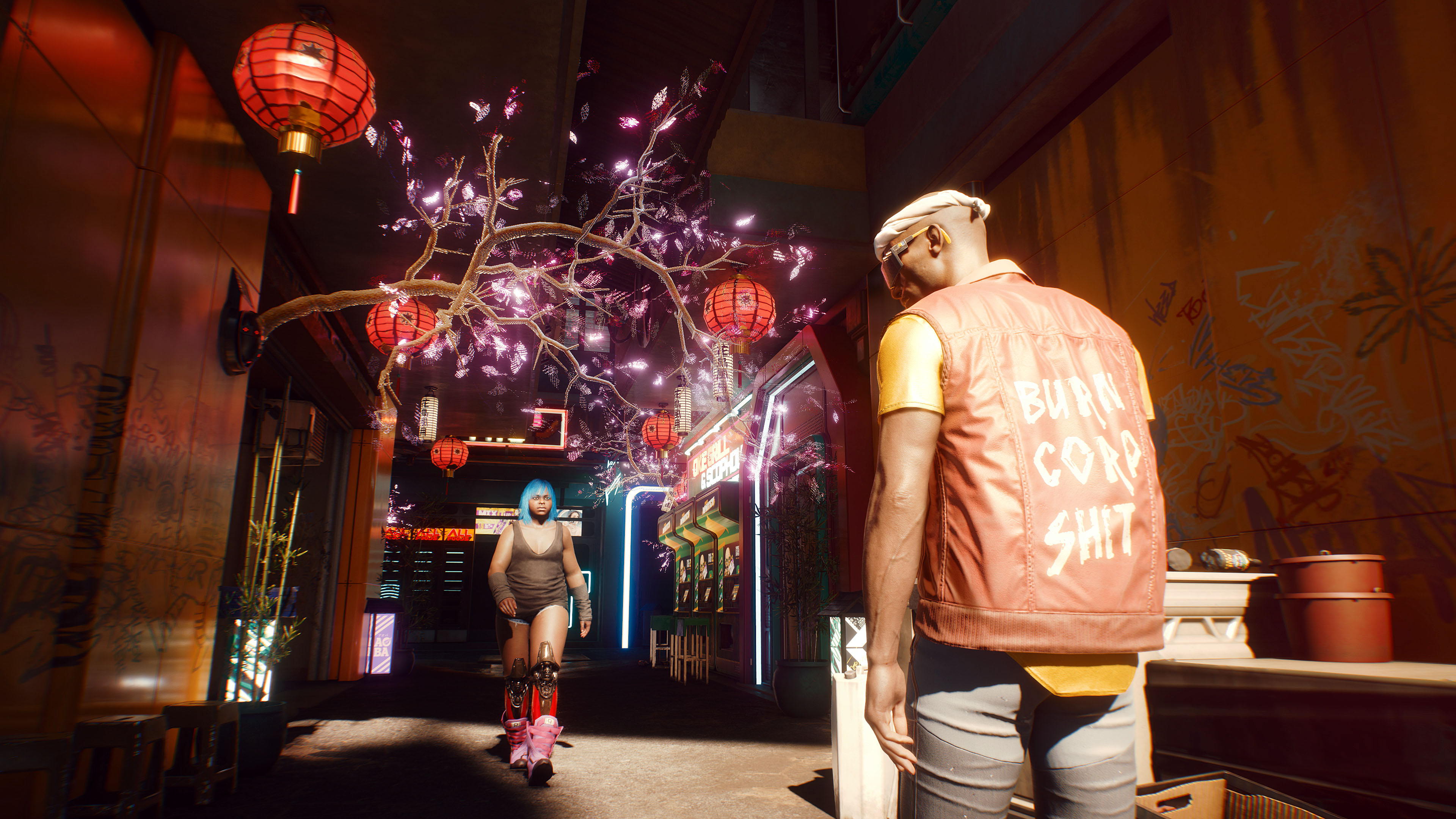
Michał: When it comes to worldbuilding, this perspective helped us really generate a sense of scale for Night City and its surrounding. You can really get overwhelmed by the height of the buildings, all the neon, all the people, the traffic, the sounds of loudspeakers shouting ads at you wherever you go and this is amplified through the first-person perspective.
For instance, as you approach the monolithic skyscrapers of Corpo Plaza and tilt the camera up — the size of the buildings literally takes your breath away. This area is home to Night City’s largest and most dangerous corporations, so we had to make it oppressive and heavy. On the other hand, when you enter one of our more densely populated districts like Kabuki, you’ll find yourself in tight alleyways, squeezing between buildings, people, vending machines, and trash. It has a decidedly claustrophobic feel to it, which immediately paints the atmosphere of that area as soon as you enter it.
Q: What were the design objectives when approaching each of Night City’s districts as well as the Badlands? And what influenced the art style choices for these distinct regions of the game?
Kacper: Like I mentioned before, we used many different elements, like styles, references, lore, concept art, as well as our imagination. However, that’s just the art side of the design. We’re creating a game that has to first and foremost be fun to play. In every district, we have a bunch of quests, as well as paths from one quest location to another. These more often than not facilitate some sort of event — a dialogue between the player and another character, a vehicle-combat scenario, a race through the middle of a district — so their length has to be precise, but also support the fun factor of the experience. We had tons of scenes where the player is presented with a specific view or perspective, so we had to work on providing a nice composition set up for each scene and make art passes to support the story being told. There were a lot of things we had to keep in mind.
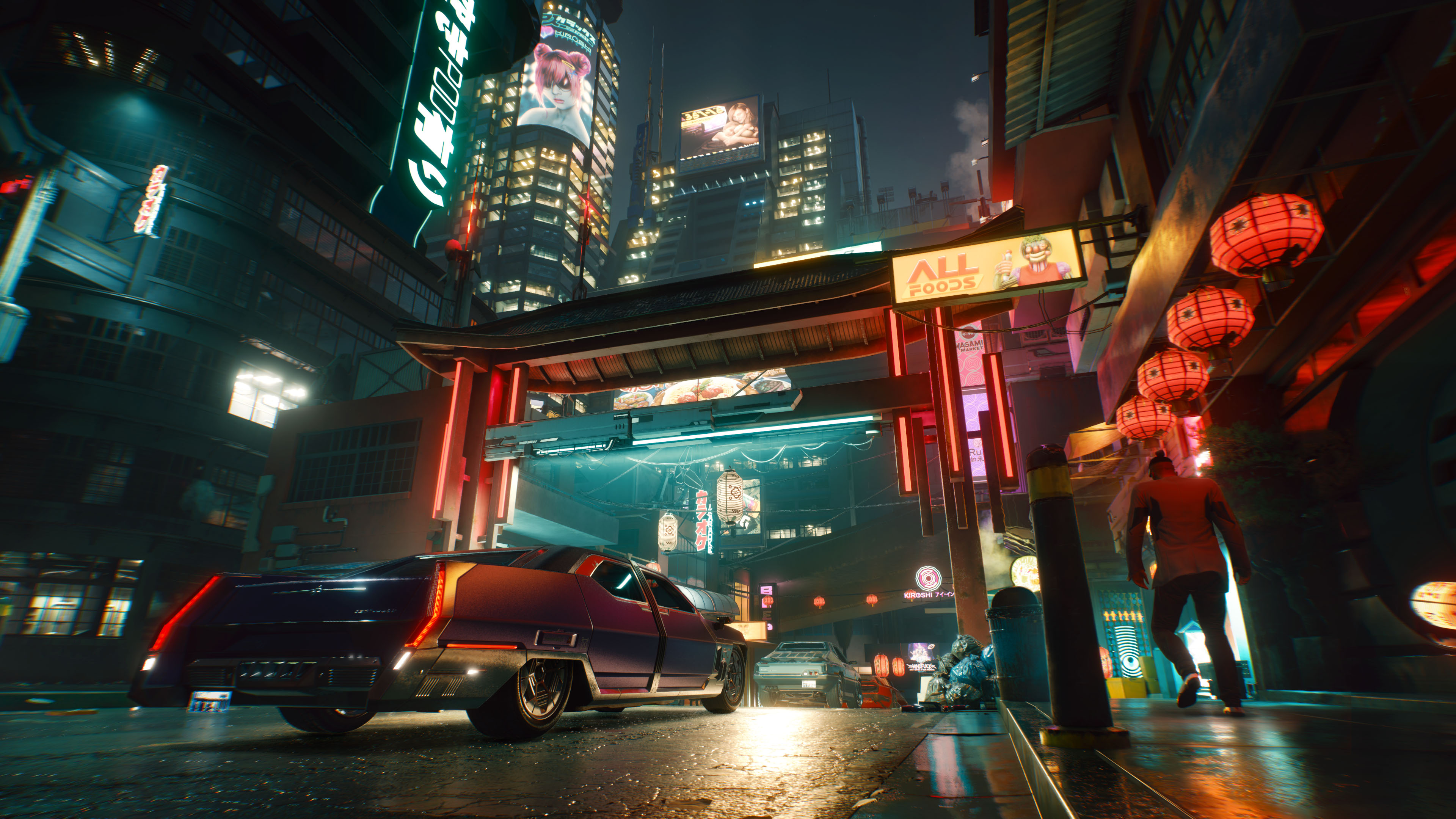
We also wanted to give certain districts a different feeling when it comes to gameplay. For example, Kabuki is heavily influenced by Hong Kong and Tokyo — and Asian culture in general. Some streets have very tall skyscrapers with apartments on top of them, but some parts of Kabuki have very low architecture constituting three or four layers. This gives the player a lot of exploration and combat opportunities both vertical and horizontal, as well as plenty of architectural-based cover possibilities. Very tight maze-like streets overshadowed by other districts creates a very unique feeling — and gameplay opportunities with it. The player will have a much different experience there than in the City Center, for example, which has a lot of open space with wide highways and more open views. All of this overseen by huge corporations, skyscrapers, and megabuildings.
In North Oak, we wanted to communicate the district’s sense of richness, luxury, and exclusivity. The base idea was to capture the feeling of cruising around Beverly Hills or Malibu. Here you will have beautiful views over the whole of Night City which, I would say, makes you feel safe from all of its dangers. But don’t let that fool you into thinking you really are safe. You can easily get hurt when in North Oaks, and even as a cyberpunk like V you’ll want to constantly be on your guard.
In Charter Hill, which is the second richest part of Night City, you will find a lot of high-end buildings where corporate agents live. From the top of some of these buildings, you’ll have a magnificent view over Night City, and it may give you the feeling that, just for a moment, you’re also part of the elite — looking down at the poor city dwellers who just aren’t so lucky.
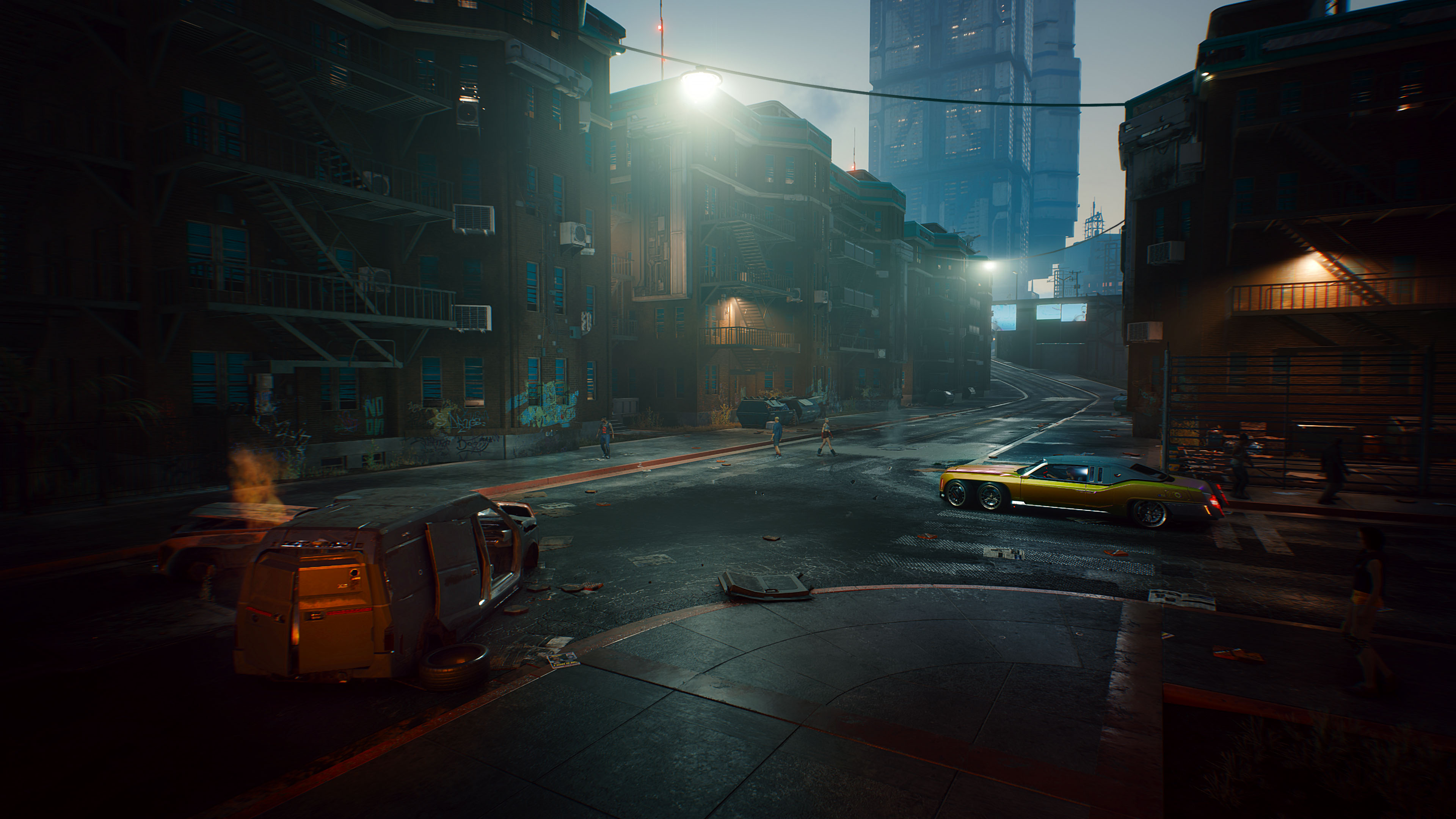
Turning our attention to somewhere more residential, we have Rancho Coronado which will give you the feeling of being in South Central L.A. mixed with Detroit. These are the very dangerous outskirts of Night City, where you need to have eyes in the back of your head at all times.
Nearby is Arroyo, which is an advanced industrial area that offers a lot of combat and exploration opportunities with industrial structures, pipelines, layers of highways, and fast connections with other districts.
On top of that, we have the Badlands, which are something totally different. This area is defined by its large open desert, where you can find old solar fields, trash landfills, power plants, protein farms, and old abandoned trailer towns — to name a few. That open desert gives you freedom. You can go wherever you want there, and do whatever you want. Brace yourself, though — the Badlands carries its own special brand of danger.
Michał: Japantown is definitely where the party’s at. This is where the corpos of Arasaka come to blow off some steam in various legal — and less legal — establishments. The latter are a specialty of the Tyger Claws, a vicious gang that controls the district and preys on the newcomers. That’s just the surface, though. We wanted to make sure that we show different styles and influences and, in this way, tell stories with our environments. Look around and you’ll find another side of Japantown, that of the monumental shanty-like skyscrapers behind all the neons and glamour. Shrines, holographic lanterns, and gang graffiti are the everyday surroundings of Japantown’s inhabitants.
This tradition of a certain duality in our environment work started way back in the days of development of The Witcher — and it lives on in Cyberpunk 2077. We’ve made efforts to show that even within a single district you can spot different influences, dictated by gangs, or simply by communities trying to co-exist in this Night City melting pot.
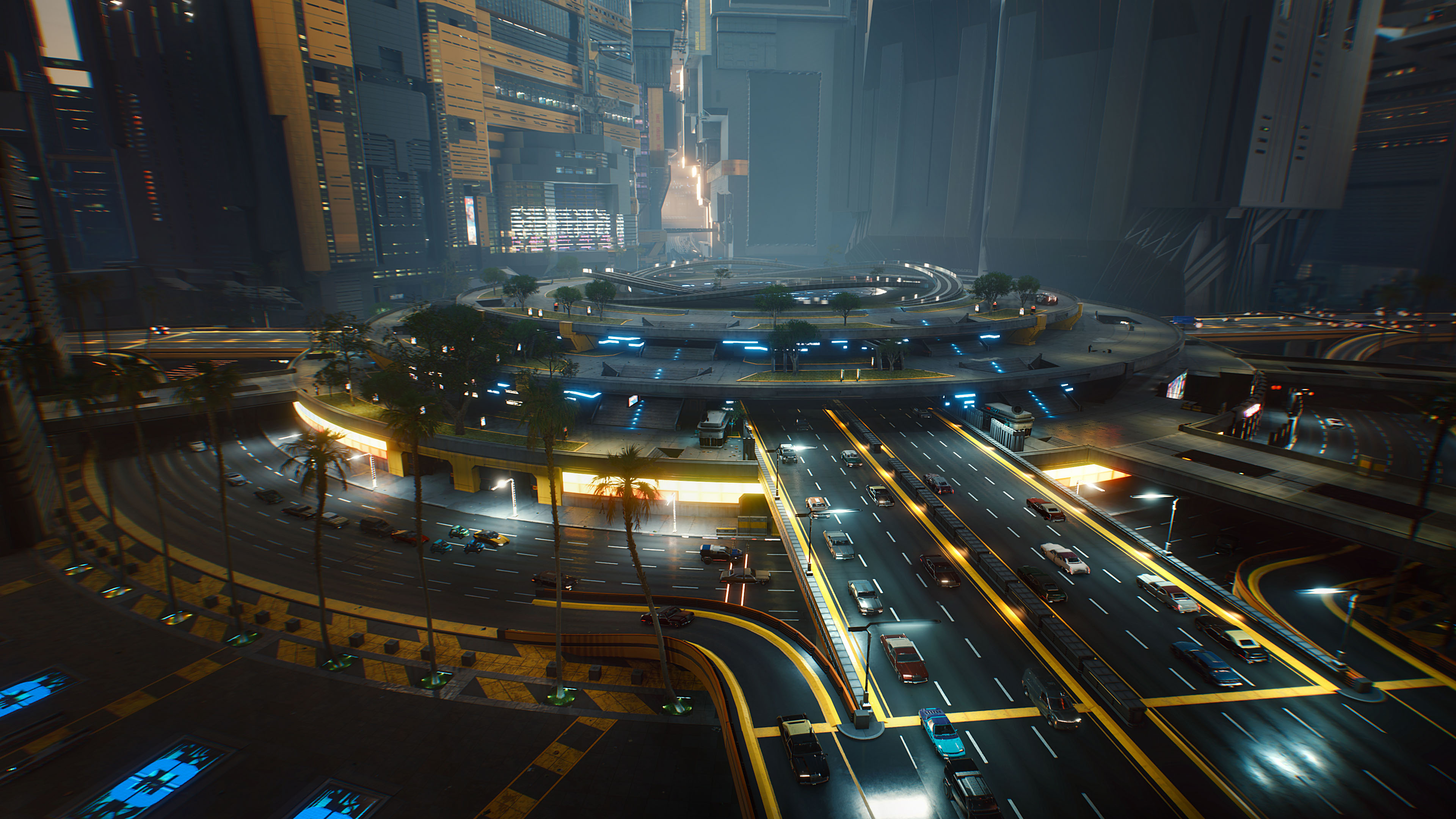
The City Center is the district of ominous skyscrapers where the corporations can freely show off their power. It’s where all the money is being made. Clean, simple glass and metal surfaces create these massive Neomilitaristic monuments that shoot into the sky, lit up by bright floodlights. From a distance, it looks like a huge, impenetrable black bunker. Here you will find the Night City crown jewel, Corpo Plaza, the name tells you everything. Huge open spaces with wide alleys and fast highways where you feel overwhelmed and out of place. This district is mostly based on concepts influenced by Syd Mead and Akira — with our own Cyberpunk twist.
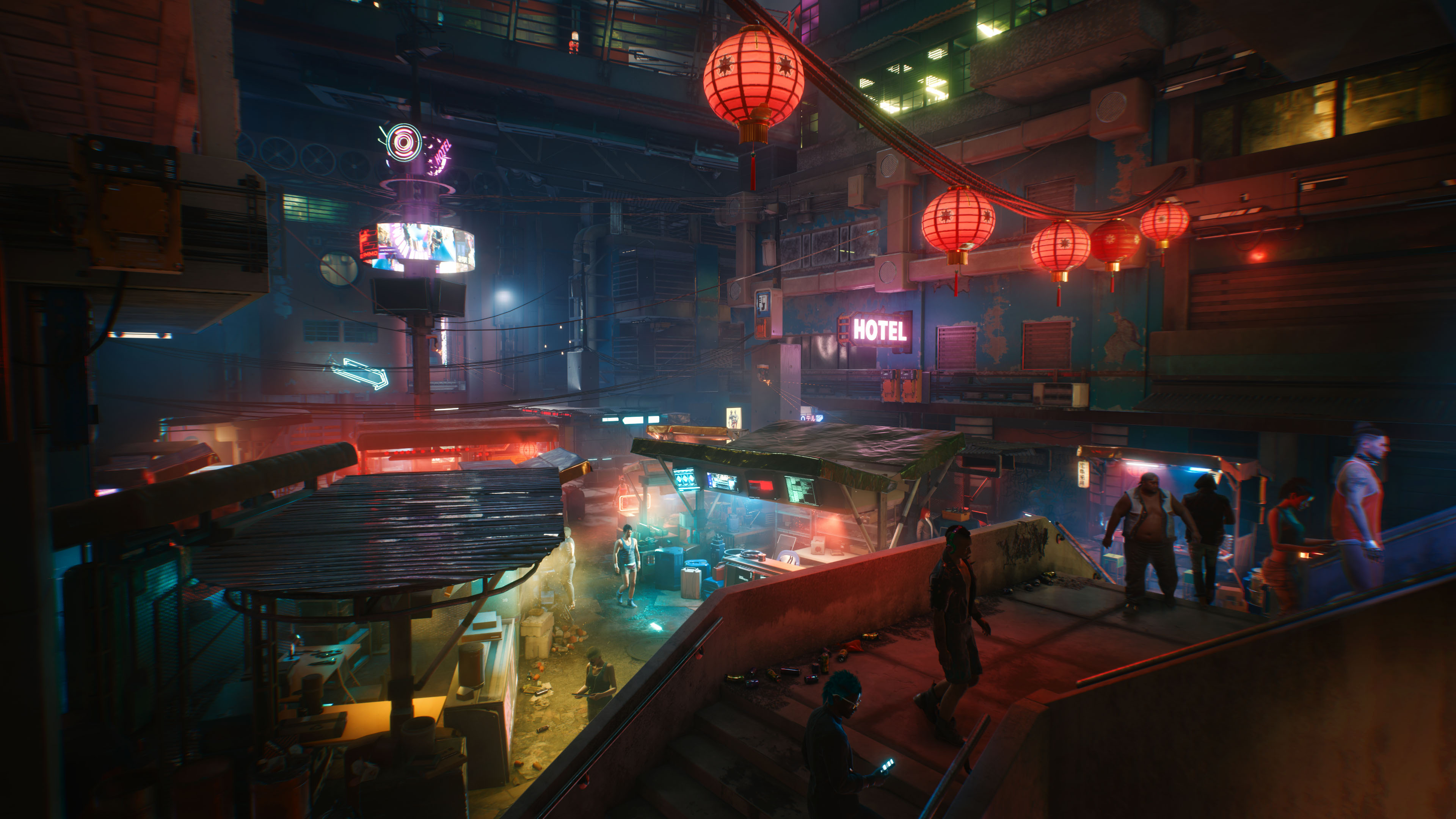
Next, there’s Little China. The skyscrapers and a high-density urban grid make this place feel like a second City Center, but with a feeling of doom permeating throughout. Overpopulated with immigrants, Little China has a very distinctive architectural style. Southside is where the tallest buildings dominate, while Central Little China resembles the poorer parts of Japantown.
North Industrial District is the harbour of Night City. A low line of working-class apartment buildings with chimneys and pipes entwine the area. Here in the skyline, you can find mega-buildings that house thousands of Night City’s residents. The visible style here is Entropism — Necessity Over Style. Here we base our work on references from Detroit. Waste areas that are occupied by factories make a perfect home for the brutal Maelstrom gang.
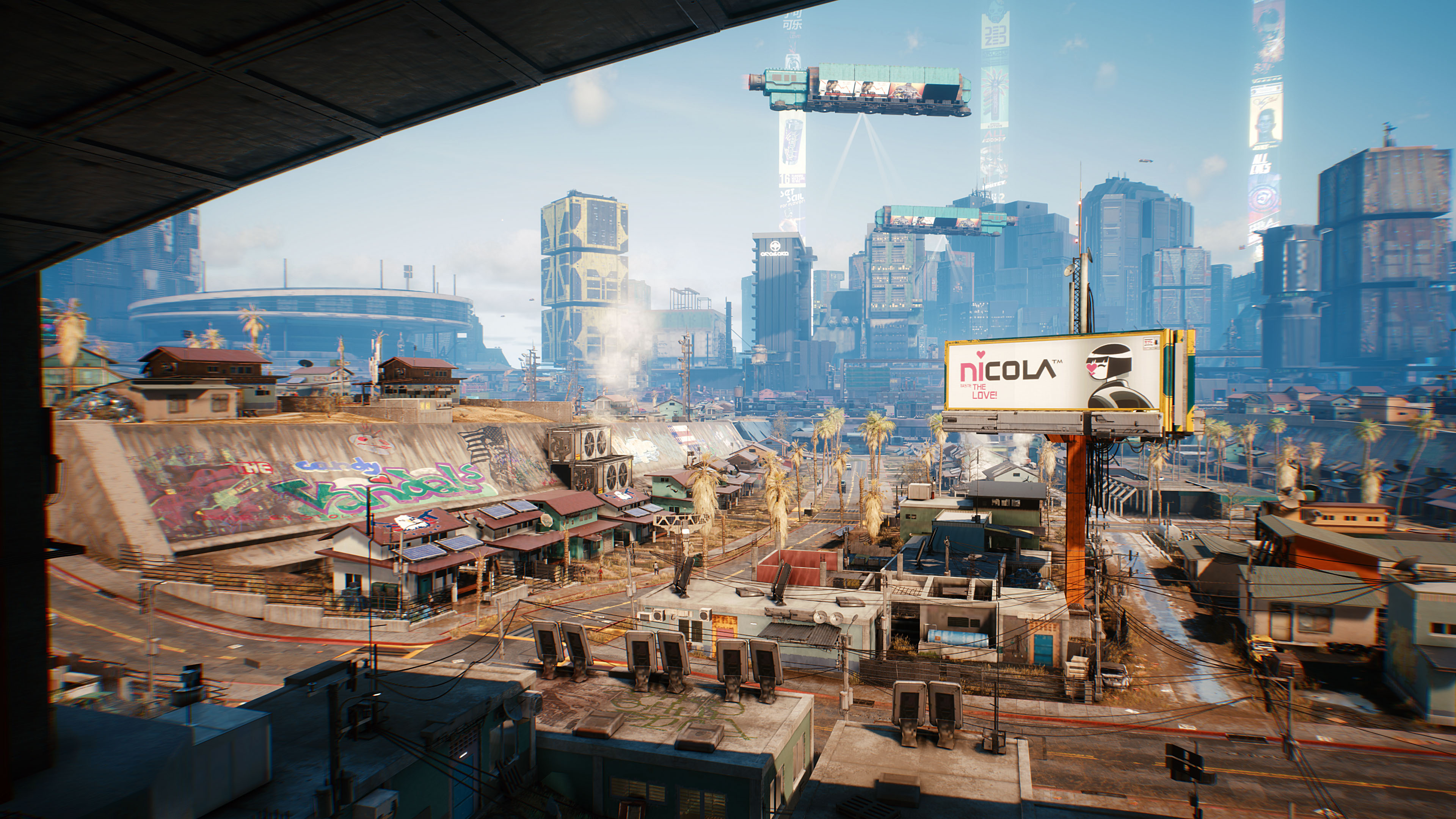
Arasaka Waterfront is the most modern advanced automated harbour of Night City, completely owned by Arasaka. Here you can find a lot of high-tech laboratories that support the corporation with cutting-edge technology and weapons. This sub district’s composition is based on concept art referencing a motherboard circuit, which perfectly reflects Arasaka’s corporate efficiency. The iconic point of interest for this district are three monumental cargo bays, housing huge AVs that travel above the city.
Heywood has many faces, but none more alluring and beautiful than Wellsprings. This is Night City’s own take on Miami, with long boulevards lined with palm trees, silhouetted against the sun setting over the sea. It shares a border with Downtown, so Wellsprings is a fairly safe district — perfect for an afternoon stroll or a shopping spree. But if you drive through Heywood and head for Japantown, you’ll have to pass through Vista Del Rey, a poor neighborhood controlled by the Valentinos. This is where their most shady deals take place, so you better make sure you don’t get lost in its maze of alleyways.
Between Wellsprings and Vista Del Ray we can find The Glen, the Valentinos’ enclave. Mainly inspired by the Bronx and Detroit, here Entropism meets with Neomilitaristic brutalism. In the south, you’ll find brick and plaster buildings creating a maze of alleyways, while on the north side you’ll see growing, overwhelming structures where The Glen neighbours the City Center.

Pacifica is the last district in Night City. Supposed to be its own little Las Vegas — a luxurious area filled to the brink with hotels, casinos, and amusement parks. Investment in Pacifica started, but the funds quickly dried up and empty buildings are all that’s left from the glittering promises. The neighborhood is now overrun by those less wanted in the better-off districts of Night City, namely the homeless and two gangs: Voodoo Boys and Animals.
Q: With this impetus for visual variety in creating distinct urban areas and a contrasting desert-scape, which Megascans assets proved most useful to the team?
Kacper: To bring Cyberpunk to life we had to create our custom pipeline for texturing objects. In short, we used our texture library for almost all the environment assets. Our biggest need was organic assets — mostly used in the Badlands. Instead of modeling a lot of assets like cliffs, rocks, small pebbles, branches, and even animal skulls, we had it right there in the Megascans library. That was a huge time saver while working on the Badlands. Many of these assets were basically dropped into the engine and were ready to work with.

And a huge advantage is that all the assets come with LODs [level of detail], which helps a lot with optimization. Others, however, using source LOD and normal maps directly from the Megascans library, required some adjustments to fit with our other assets. With our custom pipeline and using mesh source geometry and normal maps, we were able to create albedo textures when needed to make the asset better fit our needs.
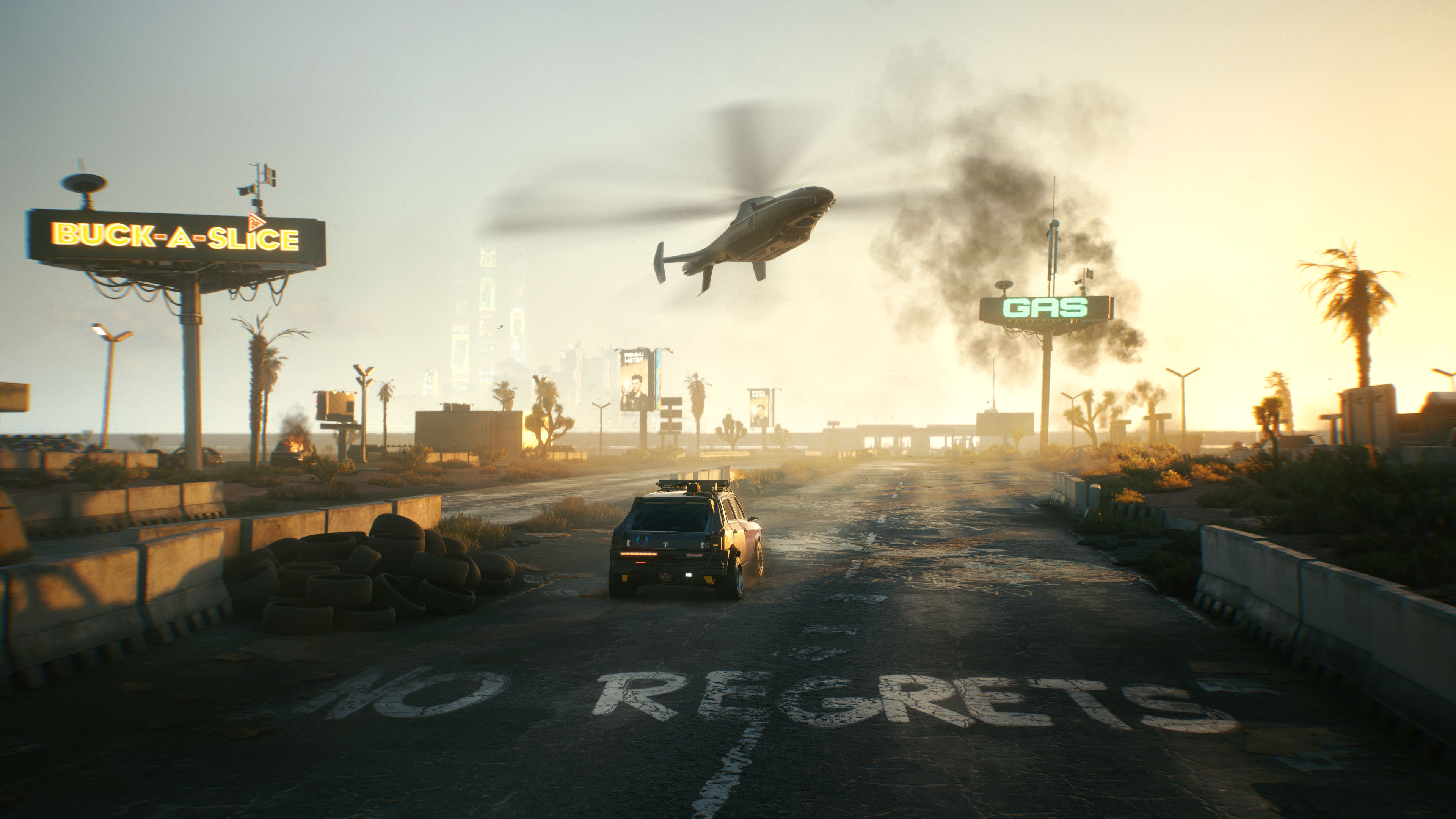
Something that also allowed us to save time was using meshes we liked available in the Megascans library (for example cliffs or other rocks meshes) for block-outs in certain places. Within hours, we had great looking locations that were easy to review and see if the direction we took was the one we liked. If it was, and combat and exploration were fun, we did a few extra art passes with some other assets, and the location was basically ready.
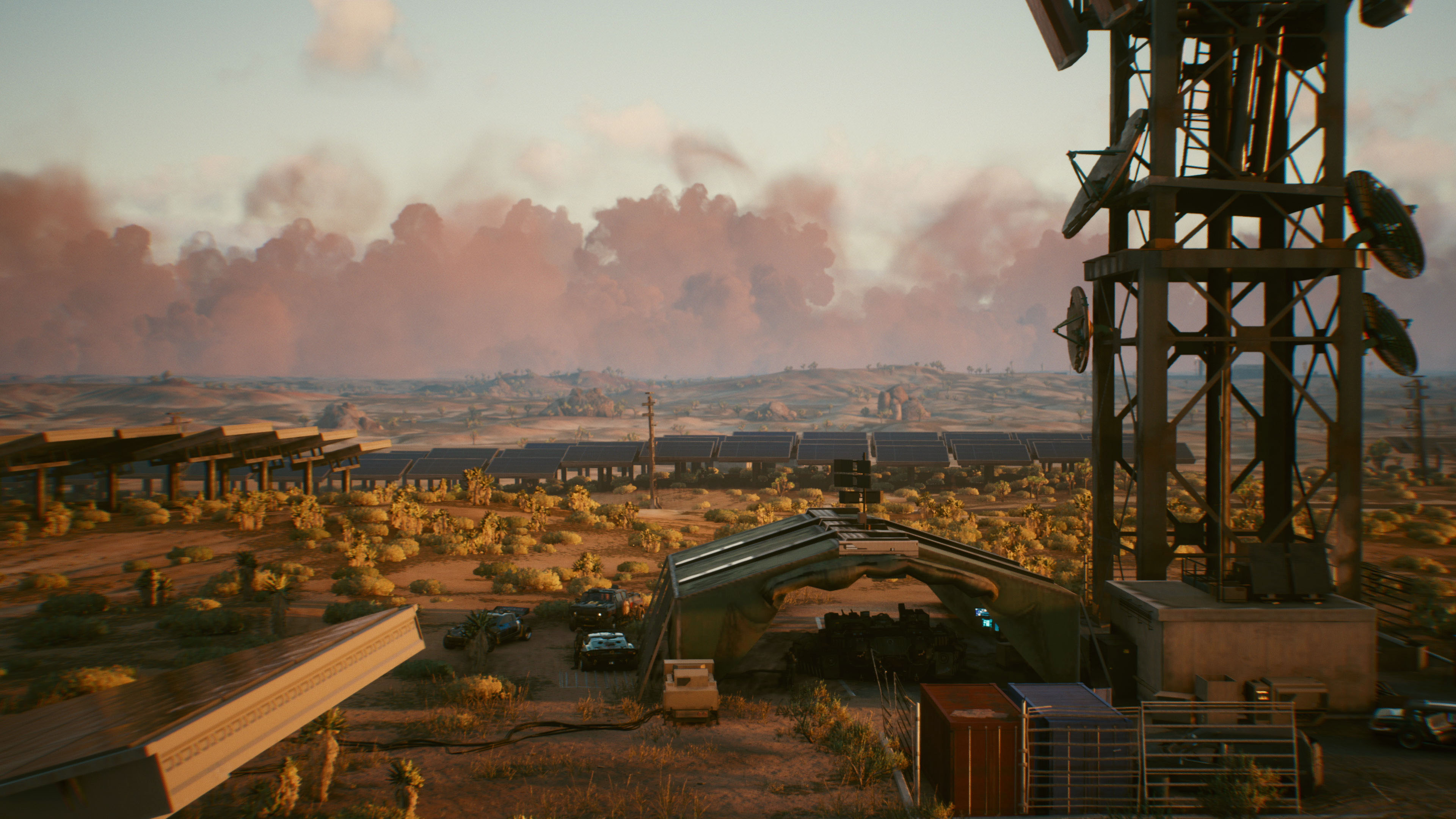
We also used a lot of vegetation. Some smaller pieces of grass and bushes were also used in the game. For other larger types of vegetation, our vegetation artist took the Megascans meshes and texture atlases and, using SpeedTree, created the custom looking foliage we needed — so much faster than doing it from scratch. We used ready meshes in terrariums and in richer houses. Our artists were using the whole package, mesh, and texture, or sometimes just took a texture and created more custom shapes to support the specific composition.

Q: Would you say that leveraging Megascans proved to be a time saver during the production? And did the art team find the 3D assets easy to work with?
Kacper: As I said before, for blocking out some of the environments or testing assets — looking for the set we liked the most — it was extremely fast and fun. Having such a great and massive library at our disposal was also a great challenge, as we had to limit ourselves only to the crucial meshes we needed. Once we had some of the bigger assets picked, it was much easier to start creating environments, as making assets can very often take a lot of time, especially when working on a set — like cliffs, for example. Then we would work first with draft meshes (grey meshes), to see if the scale and shape works, before moving forward with more detail. With 3D assets from Megascans, I was able to simply drop the asset in the game and instantly judge if it works or not.
Our Asset Modeling team had a lot of fun testing many of the assets, and they never encountered any issues while looking for the perfect ones. The same can be said when it comes to texture selection and testing to create our texture library.
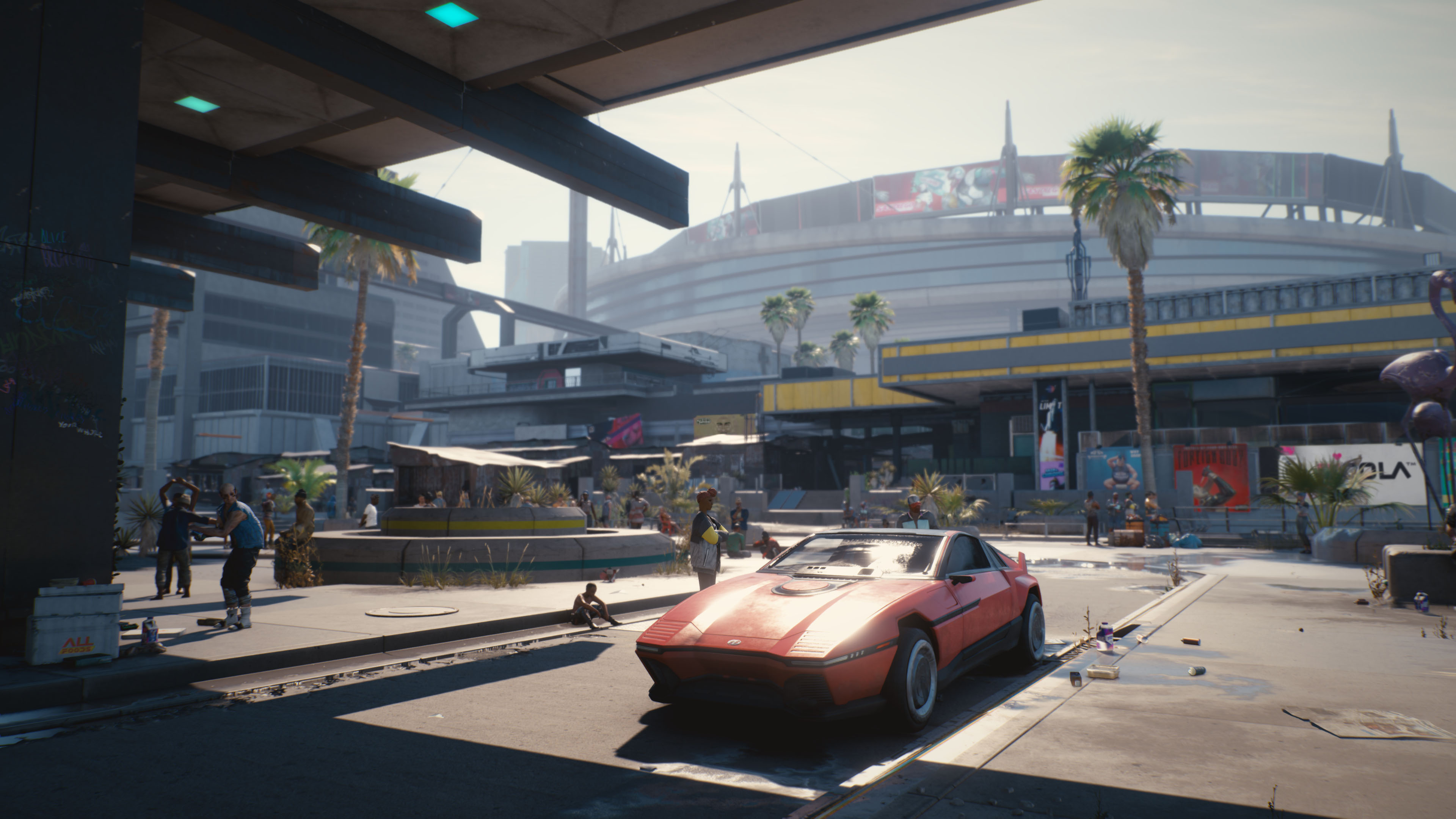
Q: Did the environment art team on CYBERPUNK 2077 have any standout favorite feature when using Quixel Megascans and Quixel Bridge?
Kacper: While creating Cyberpunk 2077, we were working on the latest version of our in-house REDengine — which was being developed in parallel as we built the game. As such, we didn’t have Bridge implementation in our engine. Most artists were downloading packages directly from the Megascans website and then importing what was needed into our engine. However, I personally love Bridge. It’s such a fast and nice way of creating asset libraries, and when I work on some of my personal projects, I just love how fast I can put whatever I like into UE4, which is my engine of choice for homework. With just a few clicks I have a ready-to-go asset in the engine. Speed and quality, I love that.
Q: A big draw for the game is the fact that it will be next-gen compatible. Was the team confident in the ability of Megascans assets to hold up to the high bar you’ve set for the next-gen up-res on all fronts?
Michał: Making sure that you’ll have an ultra-immersive experience in Night City regardless of your platform was definitely a priority for us. This of course includes next-gen consoles, where Cyberpunk 2077 will play great via backwards compatibility. In the future, we also plan on releasing a free update for owners of the Xbox One and PlayStation 4 versions of the game that when launched on next-gen hardware will allow the game to take full advantage of the additional power under the hood.

In general, next-generation consoles will most likely move artistic game development a few steps forward, giving developers the ability to push more detail into their scenes, supporting a greater amount of triangles and higher texture resolution. And while it’s definitely too early to talk specifics when it comes to pipelines and specific technology, I think something like Megascans, which provides high-quality assets in movie quality, is something that would definitely be advantageous in that environment.
Q: When the development of CYBERPUNK 2077 started 8 years ago, many of the 3D art tools and resources that are common today, including Quixel Megascans, simply did not exist. How do you think access to content like Megascans from the very beginning would shape your approach to production?
Kacper: I think it would be great to have this huge library of assets at the prototyping stage of just about any project. First of all for supporting quick concept arts / sketching some of the rough ideas — that would definitely be a great time saver.
The same goes for 3D prototypes. I love just to have fun with assets and try to see if my ideas work. While building scenes, prototypes — even without grey boxes sometimes — are a great way to prove whether something works or not. Having a lot of different types of assets to hand would enable me to create a lot of different scenes quickly to test different vibes and solutions.
Q: When building new digital worlds for next-gen, what barriers does CD Projekt Red intend to break with future projects? Do you think the Megascans library will be part of those efforts for you?
Kacper: Like I said earlier, I think it’s still too early to tell at this point. Our number one priority right now is Cyberpunk 2077 — that is what we’re currently 100% focused on.
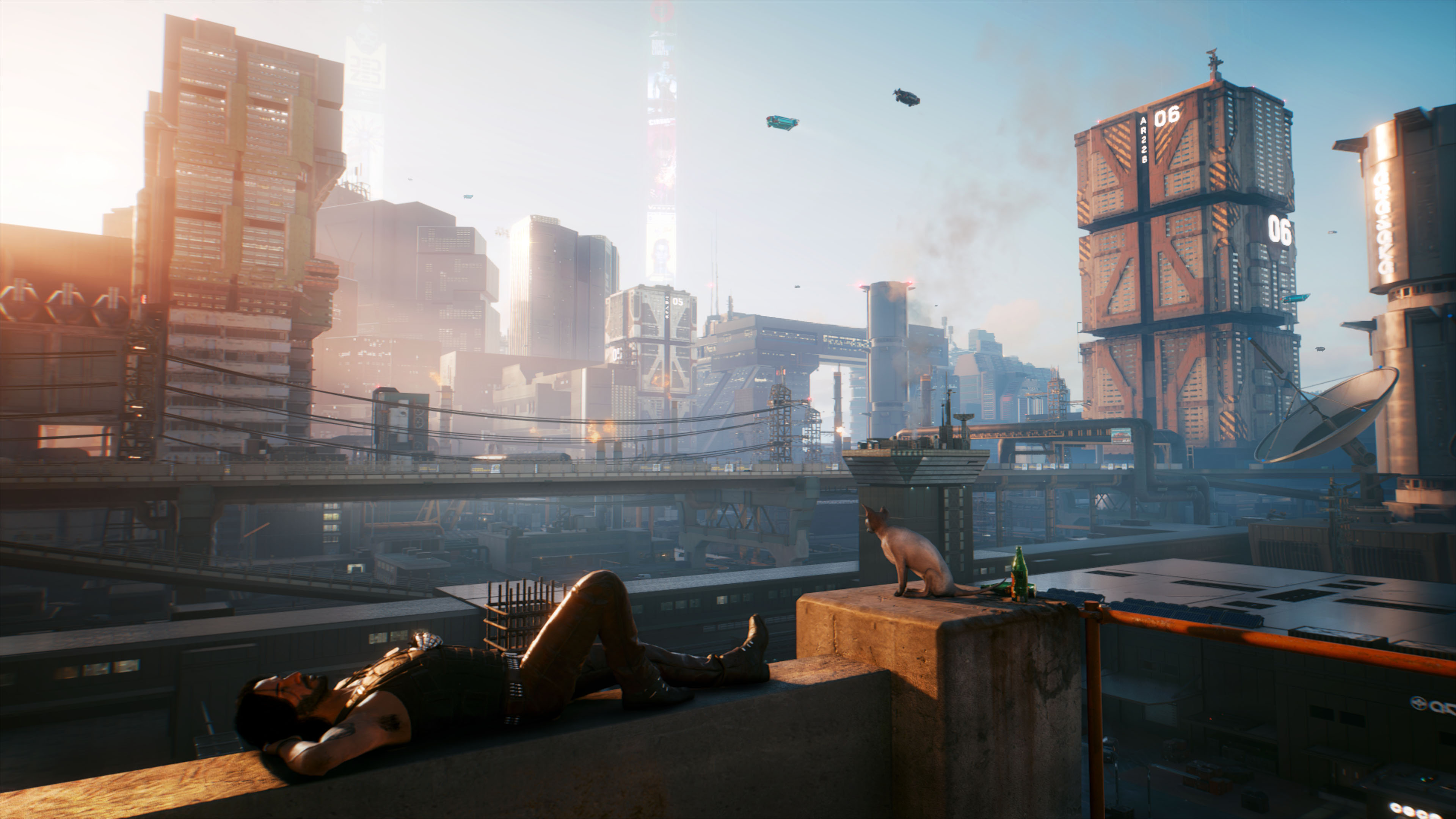
Thank you so much, Kacper and Michalł! We can’t wait to go even deeper into Night City and the world you’ve helped create.
Get your hands on CYBERPUNK 2077 today. Available for PC, Xbox One, PlayStation 4, Stadia, and also playable on Xbox Series X|S and PlayStation 5.
And follow the latest news and developments around CD PROJEKT RED.
CYBERPUNK 2077 © 2020 CD PROJEKT RED. All rights reserved.

